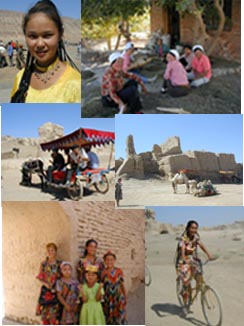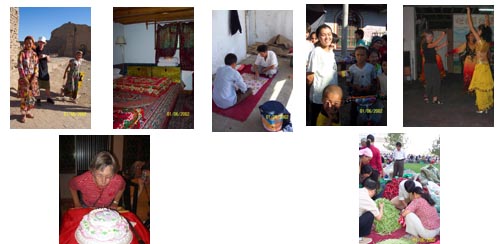|
GROUP
JOURNAL FOR

MONGOLIA, CHINA, KIRGYZISTAN, KAZAKISTAN
THE SILK ROAD
Aug.28, 2003 - Sept. 15, 2003
Day 09 FRIDAY
WEST CHINA URUMCHI TO TURFAN
September 5, 2003
Submitted by Diane Divelbess and
Mary Madison
ddivelbess@hotmail.com
mad-mac@webtv.net
Several of
us were up early to visit and photograph the morning
farmers' market in
downtown Urumqi. Meat, eggs, breads,
vegetables and fruits galore. The
market
is only open for a
brief time in the morning; the vendors/farmers break
down their
stalls quickly and haul their produce away in carts, many pulled
by
bicycles.We
checked out of the Hong Xin Hotel (but stored |
|
 |
|
our luggage there) and were
on our
way by bus to visit China's great desert region of Turpan. In Urumqi we
passed
a couple of amusing business signs in English: Hair Again Center and
Everbright
Securities. We passed two hills with pagodas and on top of one of the
hills was a
statue of General Lee who had fought the British in the Opium War. Meli commented on
the fact that CNN broadcasts had
been cut off by the Chinese
government ever since they had announced the visit of the Dalai Lama to
the United States.
Our guide, Ajim, gave us an overview of Chinese political history from
early 20th Century to the present day.
Diane mentioned that an excellent
book is
Theodore White's, Thunder Out of China. Urumqi itself is a prime example
of the China government's ability to transform an area. Again and again
we
saw entire blocks of the old adobe houses
and neighborhoods being
bulldozed and new buildings going up in their place. Anita, who had
visited
Urumqi in 1989 and in 1991
, said the change is almost unbelievable. The
Han Chinese are now the majority population in what has up to now been a
Uygur city (pronounced "weegur").
Some sights along the way were huge wind farms and the largest salt lake
in the Tien Shan area (Turpan is in the SE part of this region)
a lake which has water clear enough for animals to drink on one side of
it, but very salty water on the opposite side.
We also passed a cemetery composed of large mounds covered with bricks.
We were traveling on a well built highway - a toll road.
Ajim said that China is building several big highways by initially
obtaining loans from the World Bank. The bus pulled off at a modern
rest stop (good toilets) with a very complete gift/souvenir shop, with
probably the highest prices of any place we have been.
After the WC stop we headed down into the desert (which reminded me of the
desert areas in Southern California).
Ajim said a name for this region is Tatlimakan which means "go and never
come back". He also mentioned that in this area is a huge forest of
poplar trees, the oldest one of which is 3000 years old. We saw many
adobe brick "houses" for drying grapes. The walls of these small
rectangular flat roofed buildings are made with many air holes and contain
racks of grapes which take about three weeks to dry.
We actually went inside one of these "cool houses" in the afternoon. The
amount and variety of raisins in Turpan is impressive.
In the city of Turpan we saw that they had timed traffic signals like
those in Urumqi, and also very wide streets. By noon we were
checking in to the Turpan Oasis Hotel. Meli had requested that we stay in
the "basement" or below ground level rooms which are
cooler. The rooms were not only comfortable, they were wonderfully
decorated in Uygur style. I felt as though I had stepped into a
Matisse painting!
We drove to a Uygur restaurant for lunch. It was very festive because a
circumcision party was going on and everyone was all dressed up.
Outside the restaurant we saw a group of men sitting on the ground and
playing a board game using very large round wooden pieces for the
"players". Was this a form of chess?
WE went to many places after lunch. First, the Emin Minaret and Sulyman
Mosque. Many tourists visiting, (remember the men wearing the
"Marlboro cowboy hats?) and many stalls for shopping along the entrance
way. Meli bought dried Hami melon for us to try. At one point
(in the middle of nowhere) we stopped to peer into a very deep well shaft
of the Karez irrigation system, an ancient system which allows
this hot dry desert to be so productive. We stopped at a market in a
village outside Gao Chang City. It was wonderfully crowded,
especially with kids wanting to pose for pictures. The women in this area
wear "flashy" colored clothes, some with fabric using metallic
threads and others in ecot weave using red, green, white, black and
yellow. At the entrance to Gao Chang City we got on donkey carts
and bounced our way furiously to the ruins. Gao Chang existed from the
8th Century to the beginning of the 13th Century, though its
period of prosperity was over by the 11th Century. Then to the Bezikelik
Grottoes, the ruins of some 72 caves decorated with Buddhist
images. Many caves were destroyed by earthquakes and many by Muslims, but
some murals were cut out by early archeologists and
shipped to Britain and Germany. It's nice to see that both Gao Chang and
Bezikelik are now under government protection.
We drove back to Turpan with Flaming Mountain behind us.
We enjoyed a good dinner at the hotel complete with balloons and table
decorations (from Mary R), birthday card (thanks to Anita),
birthday cake (arranged by Ajim) and gift (from Meli) in celebration of
ROMA'S BIRTHDAY! It was the second time that Roma has
celebrated a birthday while traveling with Meli - What fun!
And so on to an outside floor show on the hotel grounds featuring ethnic
Uygur dancers and musicians. The Dancers wore beautiful
dresses and costumes. Do you remember the male dancer who could move his
eyebrows so expressively? Or the female dancers who
moved their heads from side to side? The musicians were good as well; and
when the show was over the performers encouraged the
audience to participate. I can't remember all the brave souls, but I
believe Jeanette and Doris did us proud.
Another very full and wonderful day-Thanks Meli.
Diane Divelbess and Mary Madison

Back to Melitour home
page
 next page next page
|

